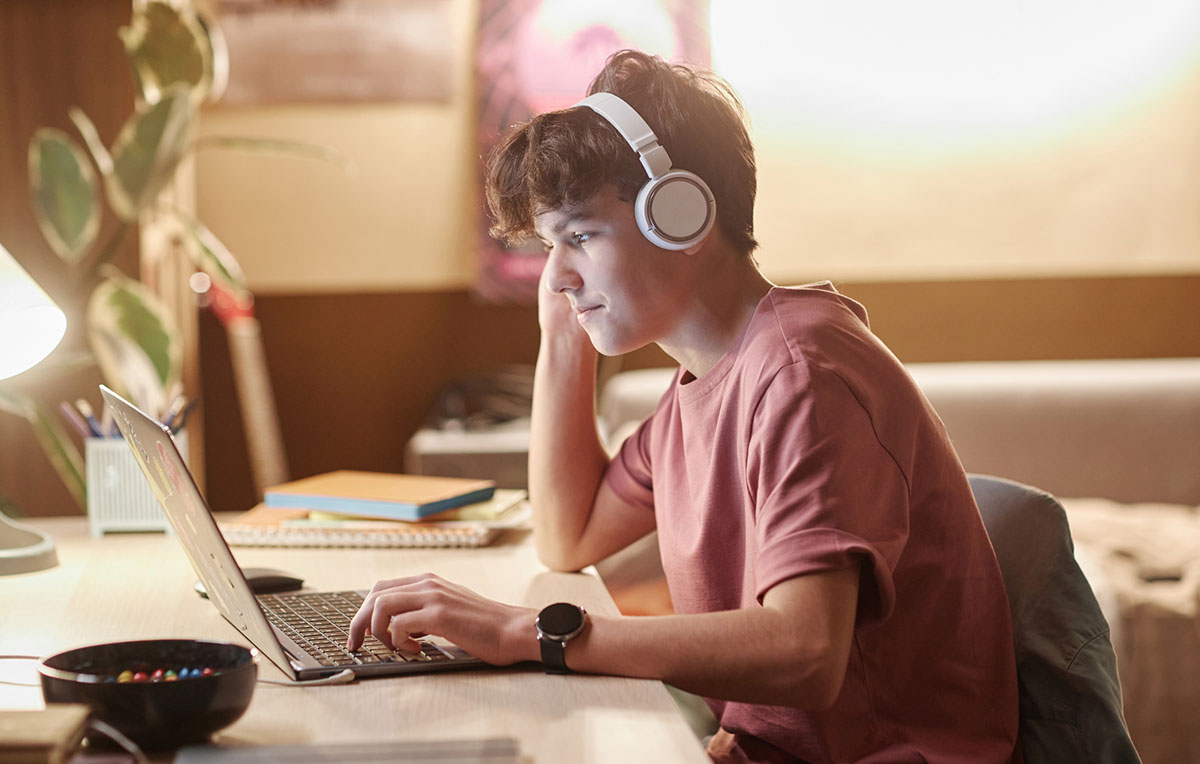What Are Teens Watching Online (and Not Telling Their Parents)?
Kids are increasingly exposed to sexually explicit content online, both unintentionally and on purpose. Though many wish they could talk to a trusted adult, parents and teens alike avoid talking about it, leaving teens to fend for themselves in the world of internet porn.
Teenagers don’t turn to parents, even when they see something disturbing, because they feel awkward or ashamed, want to avoid a lecture and restrictions, or feel it’s no big deal (Wisniewski et al., 2017). Parents, in turn, avoid the topic because they don’t know what to say, feel their input won’t matter, or fear that talking about it will increase their kid’s curiosity about porn (Dawson et al.,2024).
Further, parents overestimate how much their teens tell them and how well they understand them. In order to talk to teens about what they are seeing online, and be helpful, parents need to be in the know about why teens use porn, how it affects them, and receive guidance about what to say.
In a Common Sense Media Survey of 1300 teens, ages 12-17 across the country most reported having watched porn (Robb & Mann, 2023). More than half came across sexually explicit content accidentally by clicking a link, video, or typing an innocent word. Significantly, 71% of users who originally found porn accidentally had watched it in the last week and, of the 44 % who sought it out intentionally, most watched it regularly.
The primary reason teens seek out porn is for information about sex.
Teens use their phones and the internet as their main source of information, including when they are curious about how to have sex or perform certain sexual acts.
The top reasons teens seek out porn, in order of priority, are to learn:
1. how to have sex
2. about anatomy
3. what types of partners they like and what sexual acts they want to try
4. what will feel good to their partner
Boys are more likely to use porn for sexual gratification.
How Do Teens Feel After Watching Porn?
Interestingly, although the majority of teens reported feeling okay about their porn use, and watched for “relaxation,” (Vertongen, 2025), half still reported feeling guilty and ashamed afterwards, a sign of going against one’s values, or feeling out of control.
41% of youth said they believed watching pornography made people less respectful of the opposite sex. Only 13% disagreed (BBFC, 2019). Even non-violent porn promotes the message that doing nothing constitutes consent, and that it’s not normal to give explicit consent (Rothman et al., 2017).
The exposure of children to online pornography is impacting the development of harmful sexual behaviors, particularly viewing certain types of porn that models unsafe behaviors and associates them with pleasure and positive outcomes (Wright, 2021; Ybarra & Thompson, 2018).
The more kids used porn, the more they were exposed to violent porn, which was associated with pressuring their partner to have sex and other dominant sexual behavior. Young men who perceived pornography as realistic and identified with the actors were the most vulnerable to trying out these behaviors (Orchowski, 2019; Ybarra & Thompson, 2018).
However, when young people imitated and acted out aggressive or forceful sexual behaviors, particularly without consent, it led to being less sexually satisfied with their partner and caused their partner to feel “scared “ “anxious,” “hurt,” or disconnected (Wright et al., 2021).
A majority of teens have seen violent or aggressive porn that includes choking, rape, and inflicting pain – scripts that introduce, normalize and promote unsafe and other sexual behavior in a context of lack of consent and defiance of explicit statements of non consent, depicting these behaviors as acts that will feel good to their partner.
Choking during sex has become mainstream among youth, engaged in by a majority of undergraduates in some studies, many of whom say it’s pleasurable and mistakenly believe it’s safe, in spite of neurologists’ consensus about the risk of brain damage and death, regardless of dose and pressure modification (Herbenick et al., 2021; Joannides, 2022).
Popular advice on talking to teens about porn has focused on informing teens that porn isn’t real. However, teens are critical thinkers and already recognize that porn involves actors and doesn’t accurately depict how most people have sex. Therefore, assuming they don’t know this, and telling them what they already know, makes teens feel insulted and parents seem out of touch.
Notwithstanding, the conspicuous issue is that, in spite of being aware of porn being a performance, 45% still said they believed that porn provides helpful information about sex, perceiving it to be “as real as it gets” (Vertongen et al., 2025).
This means that recognizing the inauthenticity of porn in the abstract does not prevent teens from experiencing it as real sex when they watch, nor protect them from internalizing its impact, identifying with the actors, using it as a resource to learn about what to do, or drawing conclusions about what they think will feel good to them and a partner.
The majority of teens exposed to porn don’t use it habitually, and don’t become hooked, but some are at greater risk for problematic use in the service of escape.
Teens most susceptible to compulsive use are those struggling with painful feelings who don’t have other ways to feel better – teens who feel isolated or alone, long for connection, but fear rejection and cannot rely on parents to provide a consistent source of real contact and comfort to help regulate their emotional state. They may have a parent with an alcohol problem, other addiction (including porn or sex), or parents who are emotionally unavailable for other reasons.
In this context, children learn they cannot trust or depend on people and find reliably available ways to comfort and stimulate themselves that don’t involve relationships. Similar to substance based addictions, escape behaviors such as compulsive porn use, acting out, binging/purging, and cutting, for example become prime contenders for the job of regulating painful emotions and states of mind.
Repeated exposure to supranormal, overstimulating images in the context of sexual release, provides instantaneous transport to an altered state of mind, creating dissociation and numbness, or the rush of hyperstimulation. Compelling enough to effortlessly draw you in, and powerful enough to effectively overtake the effects of shame and pain, these methods of escape and avoidance offer a temporary out, but then backfire, perpetuating a cycle of more shame. isolation, self-absorption, and further need for escape.
Parents should be prepared and grounded before challenging conversations and use a natural segue. It’s normal to cover up behaviors that cause shame, but parents can establish a basis for honesty and openness by informing teens that they know they have/probably have watched porn, rather than testing them to see if they admit it, an approach that sets up defensiveness and derails the conversation into one about lying. Reassure them that you’re not mad, they aren’t in trouble, and it’s normal for teenagers to be curious about sex.
The first step is to find out what your teen is doing online to assess whether or not there’s a problem. Be genuinely interested in what they have to say, their experience of watching porn: the good and bad, in their view. Ask questions in a neutral, interested, respectful way, as if you were a talk show host.
- When and how did they discover porn? (Does anyone at home using a shared device have a hidden problem?)
- How often, when, and where are they?
- What apps are involved?
- What have they learned about sex, and themselves?
- What are the reasons they watch?
- How do they feel afterwards?
- How often do the images come into their mind?
- Does anyone know, or is it a secret? (A possible sign of shame)
- Have they ever tried to cut back? (A sign of feeling out of control)
- If they had to name one concern, or down side, to their watching, what would it be? (Access their internal conflict.)
Parents can be more effective at engaging their teens in conversations by leveraging the issues that are relevant and matter to their teen, such as: autonomy, being in control, protecting their reputation, avoiding humiliation, and seeking excitement – instead of discussing their own concerns.
Common mistakes parents make when advising teens are: imposing their own views, leading the witness, talking too much, pretending they are asking a question when they are in fact making a point, and failing to create space for their teen’s point of view.
When trying to influence a teen or anyone to change their behavior, an effective strategy is to locate their internal conflict, rather than imposing yours. This approach accesses intrinsic motivation -rather than compliance, minimizing opposition, and increasing follow-through.
- There are other, more sex-positive and accurate, ways to learn about sex.
- Porn gives misleading information about how to approach certain sexual acts and how they will feel, which can lead to negative sexual experiences with a partner.
- Porn is big business. You’re being manipulated so people can make money off of you. You can think you are in control when your sexuality is being shaped by someone else’s agenda.
- Your brain is under construction. What you do and are exposed to shapes the reward circuits of your brain.
- It can be hard to get these images out of your head.
- Porn is like a powerful drug when used as an escape because it instantaneously transports you into an altered state. This may bring immediate relief, but then causes shame and more difficulty coping.
- Watching porn repeatedly can trick you into thinking it will feel good to watch more but, instead, make you feel out of control.
- Shame and secrecy are signs of doing something that violates your values.
- Watching porn repeatedly and masturbating reinforces craving that level of intensity and stimulation, and makes you less able to enjoy what would naturally feel good, and less sexually satisfied with your partner.
- Getting stimulated by certain types of images repeatedly and masturbating reinforces attraction to those images and can lead to the false conclusion that you prefer a particular type of partner, sex act, gender, or behavior, even when the pull is an artifact of this cycle of exposure and reinforcement. This can lead to confusion and shame about your sexual identity – still under formation.
Parents have the power to mediate the negative impact of porn by helping teenagers sort out what they are seeing, consider how it affects them, make more intentional decisions about their exposure, including ways of reducing temptation and access to certain apps.)
The surest way to protect teenagers is to be aware of what is going on with them, and within one’s family, and create a climate in which teens can turn to you because they feel you’re interested in what they have to say, respectful, reasonable, and trustworthy (non-shaming).
Author

Dr. Lynn Margolies is a clinical psychologist in Boston, trained at a Harvard teaching hospital, and former Instructor at Harvard Medical School. Her guidance and manner gives people a positive, productive experience in sessions. Dr. Margolies is also an established writer, recognized by the U.S Surgeon General, and expert author for Psychology Today. She is dedicated to providing knowledge and actionable insights to the public, making common psychological dilemmas relatable and understandable. Through her clinical work and widely read articles, Dr. Margolies has reached and helped countless people – empowering them with tools to defuse conflict, improve their relationships with family members and others, overcome obstacles and self-defeating patterns, and enhance their lives. Visit her website drlynnmargolies.com
References
British Board of Film Classification. (2019). New research commissioned by the BBFC into the impact of pornography on children demonstrates significant support for age-verification. https://www.bbfc.co.uk/about-us/news/children-see-pornography-as-young-as-seven-new-report-find
Common Sense Media. (2023). Teens and pornography. Common Sense Media. https://www.commonsensemedia.org/research/teens-and-pornography
Dawson, K., Nic Gabhainn, S., Friday, R., & MacNeela, P. (2024). Barriers and recommendations for parent–child conversations about pornography. Frontiers in Sociology, 9. https://doi.org/10.3389/fsoc.2024.1349549
Herbenick, D., Fu, T., Patterson, C., Rosenstock Gonzalez, Y. R., Luetke, M., & Svetina Valdivia, D. (2021). Prevalence and characteristics of choking/strangulation during sex: Findings from a probability survey of undergraduate students. Journal of American College Health, 69(8), 1059–1073. https://doi.org/10.1080/07448481.2021.1920599
Joannides, P. (2022). Choking a partner during sex is as dangerous as a police chokehold. In Guide to Getting It On! (10th ed., Chapter 29). Goofy Foot Press
Robb, M. B., & Mann, S. (2023). Teens and pornography. Common Sense Media. https://www.commonsensemedia.org/research/teens-and-pornography
Rostad, W. L., Gittins-Stone, D., Huntington, C., Rizzo, C. J., Pearlman, D., & Orchowski, L. (2019). The association between exposure to violent pornography and teen dating violence in grade 10 high school students. Archives of Sexual Behavior, 48(7), 2137–2147. https://doi.org/10.1007/s10508-019-1435-4
Rothman EF, Daley N, Alder J. A Pornography Literacy Program for Adolescents. Am J Public Health. 2020 Feb;110(2):154-156. doi: 10.2105/AJPH.2019.305468. Epub 2019 Dec 19. PMID: 31855489; PMCID: PMC6951388.
Rothman, E. F. (2021). The effects of pornography on youth. In Pornography and public health (pp. 128–146). Oxford University Press. https://doi.org/10.1093/oso/9780190075477.003.0008
Vertongen, R., van Ommen, C., & Chamberlain, K. (2025). Adolescent dilemmas about viewing pornography and their efforts to resolve them. Journal of Adolescent Research, 40(1), 226–254. https://doi.org/10.1177/07435584221133307
Wisniewski, P., Xu, H., Rosson, M. B., & Carroll, J. M. (2017). Parents just don’t understand: Why teens don’t talk to parents about their online risk experiences. In Proceedings of the 2017 ACM Conference on Computer Supported Cooperative Work and Social Computing* (pp. 523-540). ACM. https://doi.org/10.1145/2998181.2998236
Wright, P. J., Paul, B., & Herbenick, D. (2021). Preliminary insights from a U.S. probability sample on adolescents’ pornography exposure, media psychology, and sexual aggression. Journal of Health Communication, 26(1), 39–46. https://doi.org/10.1080/10810730.2021.1887980
Wright, P., Herbenick, D., & Tokunaga, R. (2021). Pornography consumption and sexual choking: An evaluation of theoretical mechanisms. Health Communication, 38, 1-12. https://doi.org/10.1080/10410236.2021.1991641
Ybarra, M. L., & Thompson, R. E. (2018). Predicting the Emergence of Sexual Violence in Adolescence. Prevention Science, 19(4), 403-415. https://doi.org/10.1007/s11121-017-0810-4

